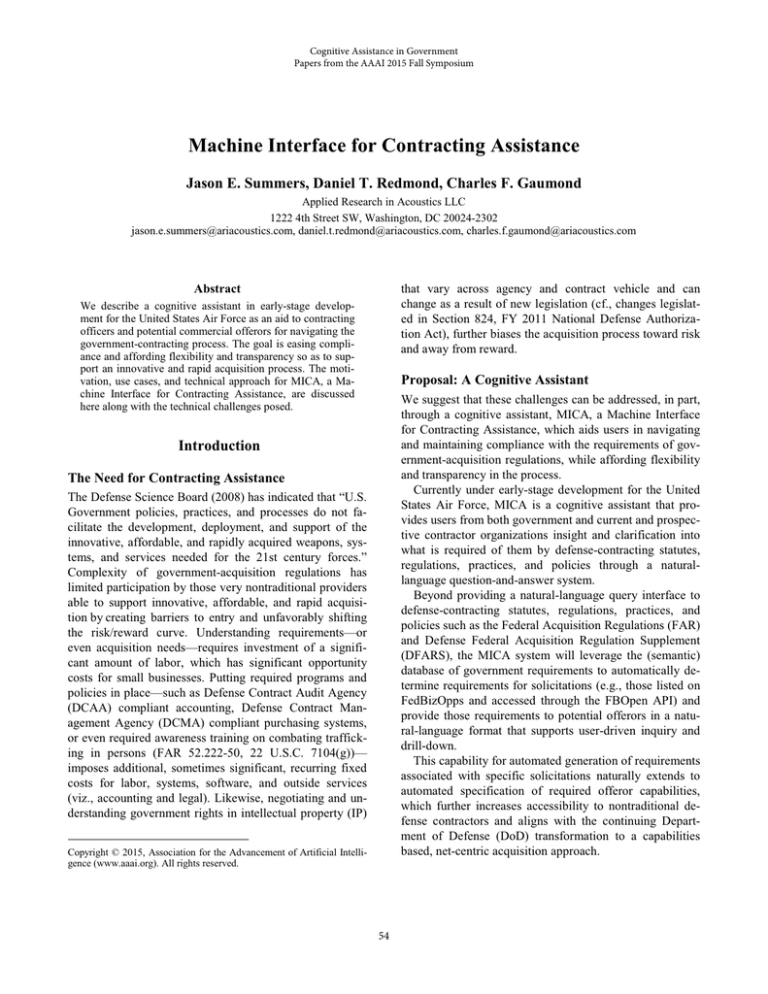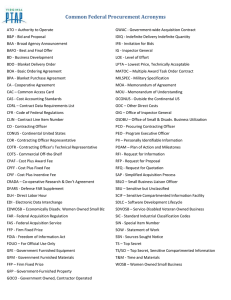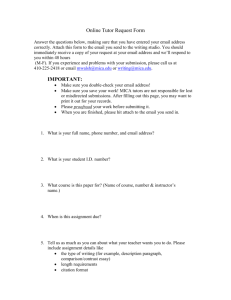
Cognitive Assistance in Government
Papers from the AAAI 2015 Fall Symposium
Machine Interface for Contracting Assistance
Jason E. Summers, Daniel T. Redmond, Charles F. Gaumond
Applied Research in Acoustics LLC
1222 4th Street SW, Washington, DC 20024-2302
jason.e.summers@ariacoustics.com, daniel.t.redmond@ariacoustics.com, charles.f.gaumond@ariacoustics.com
that vary across agency and contract vehicle and can
change as a result of new legislation (cf., changes legislated in Section 824, FY 2011 National Defense Authorization Act), further biases the acquisition process toward risk
and away from reward.
Abstract
We describe a cognitive assistant in early-stage development for the United States Air Force as an aid to contracting
officers and potential commercial offerors for navigating the
government-contracting process. The goal is easing compliance and affording flexibility and transparency so as to support an innovative and rapid acquisition process. The motivation, use cases, and technical approach for MICA, a Machine Interface for Contracting Assistance, are discussed
here along with the technical challenges posed.
Proposal: A Cognitive Assistant
We suggest that these challenges can be addressed, in part,
through a cognitive assistant, MICA, a Machine Interface
for Contracting Assistance, which aids users in navigating
and maintaining compliance with the requirements of government-acquisition regulations, while affording flexibility
and transparency in the process.
Currently under early-stage development for the United
States Air Force, MICA is a cognitive assistant that provides users from both government and current and prospective contractor organizations insight and clarification into
what is required of them by defense-contracting statutes,
regulations, practices, and policies through a naturallanguage question-and-answer system.
Beyond providing a natural-language query interface to
defense-contracting statutes, regulations, practices, and
policies such as the Federal Acquisition Regulations (FAR)
and Defense Federal Acquisition Regulation Supplement
(DFARS), the MICA system will leverage the (semantic)
database of government requirements to automatically determine requirements for solicitations (e.g., those listed on
FedBizOpps and accessed through the FBOpen API) and
provide those requirements to potential offerors in a natural-language format that supports user-driven inquiry and
drill-down.
This capability for automated generation of requirements
associated with specific solicitations naturally extends to
automated specification of required offeror capabilities,
which further increases accessibility to nontraditional defense contractors and aligns with the continuing Department of Defense (DoD) transformation to a capabilities
based, net-centric acquisition approach.
Introduction
The Need for Contracting Assistance
The Defense Science Board (2008) has indicated that “U.S.
Government policies, practices, and processes do not facilitate the development, deployment, and support of the
innovative, affordable, and rapidly acquired weapons, systems, and services needed for the 21st century forces.”
Complexity of government-acquisition regulations has
limited participation by those very nontraditional providers
able to support innovative, affordable, and rapid acquisition by creating barriers to entry and unfavorably shifting
the risk/reward curve. Understanding requirements—or
even acquisition needs—requires investment of a significant amount of labor, which has significant opportunity
costs for small businesses. Putting required programs and
policies in place—such as Defense Contract Audit Agency
(DCAA) compliant accounting, Defense Contract Management Agency (DCMA) compliant purchasing systems,
or even required awareness training on combating trafficking in persons (FAR 52.222-50, 22 U.S.C. 7104(g))—
imposes additional, sometimes significant, recurring fixed
costs for labor, systems, software, and outside services
(viz., accounting and legal). Likewise, negotiating and understanding government rights in intellectual property (IP)
Copyright © 2015, Association for the Advancement of Artificial Intelligence (www.aaai.org). All rights reserved.
54
Use Cases
The functionality and technical requirements of MICA
are best elucidated through use cases and explicit examples
of those use cases. While not all proposed use cases involve a question-and-answer paradigm, it is helpful to introduce a taxonomy of questions (after Peter Clark), that
classifies possible queries into twelve types and two categories. The first category is simple questions comprising
1. True/false
x
2.
User: Contracting Officer
Query: “What documents must be provided to sole-source a CPFF
contract for services?”
—
User: Prospective Offeror
Query: “Is a business that is majority owned by a private equity firm
eligible to subcontract on a Phase II STTR contract?”
“Are all time-and-materials contracts cost-type
contracts?”
“What is the number of clauses in FAR that provide
exemptions to full-and-open competition?”
“What kinds of contracts are there?”
“What category of thing is an ACRN?”
Use Case 2. Natural-Language Query: Complex Question
This use case comprises the complex question types
enumerated and described previously, posed in natural language by either a contracting officer or a representative of
a prospective offeror. The goal of complex questions is
primarily to understand a document or requirement, rather
than to determine the feasibility or legality of an action.
Unlike simple questions, complex questions are not well
posed in terms of formal logic queries to an ontological
database. Examples:
Possibility
x
7.
“What is the simplified acquisition threshold?”
“What are the clauses required in a non-CAS
CPFF contract?”
Taxonomic
x
x
6.
“Do cost-type contracts require DCAA approval?”
Cardinality
x
5.
Use Case 1. Natural-Language Query: Simple Question
This use case comprises the simple question types enumerated and described previously, posed in natural language by either a contracting officer or a representative of
a prospective offeror. The goal of such a question might be
to understand a document or requirement; determine the
feasibility or legality of an action; or otherwise interact
with acquisition regulations in a manner that can be expressed in formal logic. Examples:
Subsumption
x
4.
Complex questions require answers that must be expressed semantically; ideally in natural language.
Find value/values
x
x
3.
“What is the relationship between the simplified acquisition
threshold and policies to ban text messaging while driving?”
“Can a business that is majority owned by venturecapital firms receive SBIR funding under a Phase II
award?”
Meta-Reasoning
a. Functional dependence
x
b.
“Does the total value of the contract affect what
clauses must be included?”
User: Contracting Officer
Query: “What is an example of an acceptable sole-source justification
for a fixed-price subcontract issued by a prime under a cost-type services contract?”
—
User: Prospective Offeror
Query: “What happens during the contract negotiation phase?”
Following from premise
x
“The total value of the contract is below the simplified acquisition threshold, does this mean the contract is exempt from mandatory VETS-100A employment reports on veterans?”
These questions require answers that can be coded numerically (binary yes/no, integer cardinality, or real-number
values) or in terms of the entries in or structure of a
knowledge base (category or member names).
The second category is complex questions comprising
8. Definition
Use Case 3. Requirement Specification and Flow-Down
This use case comprises automatic specification from a
solicitation of those compliance requirements that will become incumbent upon a successful offeror—whether for
use by a contracting officer in developing a contract or by
contractor personnel in assessing the risk/reward tradeoff
of a potential opportunity. This specifically includes specification of possible acquisition strategies (viz., alternative
authorities for acquisition, set-asides, sole-source, etc.)
Like Case 1, Case 3 expresses logical entailments, albeit
based upon properties that are assessed automatically rather than in response to a question. Like Case 2, Case 3
requires (some) natural-language responses. While certain
responses can be provided in terms of enumeration (e.g., a
“What is required anti-trafficking in persons training?”
9.
Description
“Describe the actions and steps that must be taken during a
DCAA pre-award audit to determine adequacy.”
10. Example
“What is an example of a sole-source justification?”
11. Similarity
“What are the differences between CAS and non-CAS accounting requirements for a cost-type contract?”
12. Relationship
55
listing of required clauses), others require natural-language
instruction/guidance.
are not unstructured prose. Legal text comprising the Code
of Federal Regulations (CFR), FAR, DFARS, and other
relevant regulations is semi-structured. Information is formatted in a hierarchical tree structure and heavily cross
referenced between sections for the purpose of clarifying,
supporting, interpreting, or limiting the requirements of the
section in which the reference is found.
These references can be within or between documents
and can be expressed in a structured manner, “see 48 CFR
9903.201-1,” or in an ad-hoc manner that requires semantic
interpretation, “using the rate specified in 26 U.S.C.
6621(a)(2).”
While this differs from the standard case, it supports
extraction of semantics from syntax by giving a formal
structure to the textual context.
Technical Approach
Architecture and Training
The use cases for MICA impose distinct requirements on
the design and architecture with some areas of overlap. In
particular, all use cases require some measure of naturallanguage processing (NLP) to parse, interpret, and machine-format queries or select and format natural-language
output. However, our focus here is on those elements of
MICA that enable those capabilities that are particular to
it: acquisition-policy question-and-answer and specification of compliance requirements.
The technical requirements of Use Case 1, aside from
NLP for ingestion of queries, can be addressed within a
framework of formal semantics. In other words, the natural-language queries can be reframed as queries to an ontological database populated by ingesting the relevant source
materials (viz., FAR, DFARS, etc.) and computing (firstorder) logical entailments.
The technical requirements of Use Case 2 can be realized in at least two ways. First, a complex question can be
understood as a “compound” or “composite” question that
can be answered through (reasoning over and formatting)
the answers to multiple simple queries. Alternately (pace
Clark), a complex question can be understood as a linguistically formatted query that seeks to return a primary
source document or information extracted from a primary
source document—perhaps having undergone reformatting
or combination through result ranking and/or formal reasoning.
Presently, the technical approach we are following in the
development of MICA explicitly accounts for the distinction between these two use cases. The MICA architecture
incorporates an encoding of acquisition rules, policy, and
guidance in a structured knowledge base that supports formal reasoning and query (i.e., an ontology). It also follows
the question-and-answer paradigm of IBM Watson, learning deep semantic knowledge from shallow syntactic information (viz., primary texts) and using this learned
knowledge to interpret the semantic intent of questions and
return relevant information extracted from source documents. Both are supported in extraction and encoding of
information by domain-specific structured information
(e.g., a legal ontology customized to address acquisition
terminology).
Active Semi-Supervised Learning
Approaches such as Watson infer deep semantic information from shallow syntactic information contained in a
corpus of documents through an unsupervised learning
process (Ferrucci et al. 2010; McCord, Murdock, and
Boguraev 2012; Fan, Kalyanpur, Gondek, and Ferrucci
2012) as do (some) approaches to build a knowledge base
from text (Schubert 2002). However the question-andanswer capability for a given subject domain and corpus
requires supervised training to achieve acceptable levels of
performance (Ferrucci et al. 2010; Fan, Kalyanpur, Gondek, and Ferrucci 2012). This training is two-fold. First, it
takes the conventional form of question-answer pairs (ideally drawn from the true query space) (Ferrucci et al. 2010;
Fan, Kalyanpur, Gondek, and Ferrucci 2012). Second, it
takes the form of fine-tuning the feature-extraction process—expert guidance of the algorithms through which the
system extracts syntactic information and infers semantic
information (Ferrucci et al. 2010; Fan, Kalyanpur, Gondek,
and Ferrucci 2012). For example, a subject-matter expert
(SME) might need to indicate which clauses of a contract
or which portion of a Government Accountability Office
(GAO) decision are more critical to parse or how a sentence structured in legal language should be parsed and
interpreted. As Watson CTO and chief architect Sridhar
Sudarsan puts it, “someone with expertise in the subject
needs to identify from that corpus what bit is the right answer (Heath 2014).”
In our previous development of the SAGE semantic reasoning and suggestion engine, which integrated SME
judgments with unsupervised machine learning to optimize
the creation of simulation-based training scenarios, we
found that the training process and the performance of
SAGE could be enhanced by obtaining SME input within
an active semisupervised framework. Semisupervised
learning combines unsupervised learning of structures and
correlations from raw, unlabeled data with supervised
learning from selected, labeled data from SMEs. Active
Learning from Semi-Structured Content
Both components of MICA must ingest information from
textual documents. But, unlike many conventional text
documents, the acquisition rules, policies, and procedures
56
learning uses an algorithmic approach to determine which
pieces of labeled data will be most informative and solicits
those from SMEs. This both accelerates and improves the
quality of the learning process.
For MICA we have developed an active-learning approach that operates by forming a dynamically updated
ontology from the question-and-answer pairs input to and
returned by the system. Through automated machine reasoning over this ontology to discover logical inconsistencies, SMEs are cued to provide targeted training that addresses failures in semantic inference. As Sudarsan has
noted, training Watson “is not a one-time exercise, it's really an ongoing iterative approach (Heath 2014).” Our active
semisupervised approach to SME engagement optimally
supports that iterative learning. Similarly, the semisupervised architecture also supports integration of side information, such as user up/down voting, to improve response
quality in a lifelong-learning approach.
modifications to language during the legislative process,
conflicting agency interpretations of executive or intraagency mandates, or simple error. Watson and similar systems assume the semantic information implicit in the unstructured documents of the corpus is consistent. But such
systems typically do not check this information for consistency in the manner of a formal ontology (e.g., as in
Wolfram Alpha), presuming that supervised training will
provide sufficient information about relevant contexts to
guide the algorithm to the appropriate data source given
information implicit in the queries. Because MICA forms a
formal ontology during training, it is able to direct attention to portions of the acquisition regulations that require
such context-information distinction or may, in fact, be
inconsistent. This is a significant side benefit of MICA.
Currently, inconsistencies are often addressed through legal actions pursued through the GAO or the United States
Court of Federal Claims. MICA allows inconsistencies to
be addressed within agencies before protests arise.
Technical Challenges
Parsing Legal Language
The syntactic parsing (McCord, Murdock, and Boguraev
2012) structured databases (viz., DBpedia and WordNet)
(Ferrucci et al. 2010) and semantic-inference algorithms
systems like Watson rely upon (Fan, Kalyanpur, Gondek,
and Ferrucci 2012) assume natural-language constructions
and conventions for representing meaning. In contrast,
legal documents, such as acquisition regulations are written
in legal language that may provide a challenge to a Watson
like system or conventional NLP parsing of the information into a structured semantic knowledge base (just as
it does for many people).
References
Defense Science Board Task Force on Defense Industrial Structure and Transformation. 2008. Creating an Effective National
Security Industrial Base for the 21st Century: An Action Plan to
Address the Coming Crisis. Technical Report, Office of the Under Secretary of Defense for Acquisition, Technology, and Logistics.
Heath, N. 2014. Five things you need to know before building an
IBM Watson app. URL http://www.techrepublic.com/article/
fivethingsyouneedtoknowbeforebuildinganibmwatsonapp/
Fan, J.; Kalyanpur, A.; Gondek, D. C.; and Ferrucci, D. A. 2012.
Automatic knowledge extraction from documents. IBM J. Res. &
Dev., 56(3/4):5:1–10.
Ferrucci, D.; Jennifer Chu-Carroll, E. B.; Fan, J.; Gondek, D.;
Kalyanpur, A. A.; Lally, A.; Murdock, J. W.; Nyberg, E.; Prager,
J.; Schlaefer, N.; and Welty, C. 2010. Building Watson: An overview of the DeepQA project. AI Magazine, Fall:59–79.
McCord, M. C.; Murdock, J. W.; and Boguraev B. K. 2012. Deep
parsing in Watson. IBM J. Res. & Dev., 56(3/4):3:1–15.
Schubert, L. Can we derive general world knowledge from texts?
M. Marcus (ed.), Proc. of 2nd Int. Conf. Hum. Lang. Tech. Res.
(HLT 2002).
Cross-Document Inference
Interpreting acquisition regulations requires crossreferencing between multiple documents: DFARS refers to
the FAR, which in turn refers to USC. Moreover, regulations are subject to clarification (e.g., in memoranda from
the Under Secretary of Defense) and interpretation (e.g., in
United States GAO bid-protest decisions). While the design of Watson (and similar systems) allows for inference
across multiple documents (Ferrucci et al. 2010; Fan, Kalyanpur, Gondek, and Ferrucci 2012), the ability to do so
depends on (1) appropriate choice of the corpus contents
such that they span the query space and (2) guidance from
SMEs during feature-extraction learning. In MICA this is
supported by a taxonomy of the query space within an ontological framework that supports automated selection of
corpus documents based on SME input and the active semisupervised learning framework.
Acknowledgements
The work described here was performed as part of an effort
sponsored by the Air Force Research Laboratory (AFRL).
Inter- and Intradocument Consistency
Because of the size and complexity of acquisition regulations, inconsistencies can and do occur between documents
and within documents as a result of imprecise language,
57







